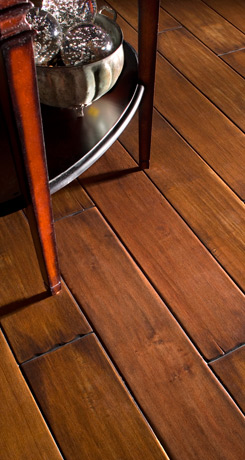Hardwood
Routine Maintenance
Keeping your hardwood floors looking great is quite simple when you keep in mind some simple guidelines:
- Frequently sweep and vacuum the floor to remove loose dirt before it can scratch or be ground into the floor’s surface.
- Never clean or wet mop your hardwood floor with water. Do not use any wax or cleaner that must be mixed with water, such as oil soap, as this may ruin your floor and result in a loss of warranty. Water can dull the finish and permanently damage the floor.
- Spread manufacturer’s suggested hardwood cleanser directly on the floor and wipe with a sponge mop or appropriate cleaning applicator. Do not allow puddles of cleaner to remain on the floor’s surface. Excess liquid may damage the fiber of the wood.
- Place walk-off mats designed for hardwood floors at each entryway to minimize spreading dirt and grit throughout the house; remember to shake them out regularly. Tiny particles of dirt and stone are like sandpaper and will scratch your hardwood floors. Avoid using rubber-backed or non-ventilated mats or rugs as they can damage your floor by trapping moisture. Rugs and mats should be moved occasionally as they block sunlight, which may give the appearance of discoloring under the rug.
- For spot cleaning, apply cleaner to a clean cloth and rub onto the spot. Never apply wax agents to a urethane floor.
Preventative Maintenance
- Keep in mind that soon after your hardwood floors are installed, they’ll begin to “mellow” and their color may change a bit. No matter what type of hardwoods you choose, you can expect some slight changes to occur due to exposure to sunlight, temperature, and oxygen. The first few months after installation will be the time of the most extreme change. During this time, you may want to limit or eliminate the use of throw rugs and keep bright light to a minimum to prevent drastic differences in floor coloring.
- In addition to the photosensitivity your floor will be undergoing in the first few months, the coating is also curing in the first month or so. During this time, it is best to not put down rugs – even with rug pads – so that patterns don’t wear into your hardwood floor’s surface.
- Use floor protectors on the feet of furniture to avoid scratches.
- When moving heavy furniture or appliances, use extra caution to help avoid scratching, indentations, and gouging. Some objects may be too heavy to be moved across a hardwood floor under any circumstances; in the event that something of this nature would need to be moved it should be lifted, not slid across the floor.
- Certain types of casters on furniture may damage hardwood flooring. Barrel-type caster wheels or wide, flat glides are best for protecting your hardwood floor. If your furniture does not have the right type of caster, we recommend that you change them.
- Wood stoves and electric heat tend to cause very dry conditions. A humidity level of 35-55% is recommended for hardwood floors. In extremely dry conditions, a humidifier is recommended to prevent excessive shrinkage of wood floors due to low humidity levels.
- In damp conditions, proper humidity levels can be maintained with an air conditioner or dehumidifier, or by periodically turning on your heating system during the summer months.
- Spike or stiletto high-heel shoes, especially those in poor repair, may cause denting and related damage to hardwood floors due to the extremely high compressive force they generate.
- Pets’ paws and nails can scratch and dull hardwoods if your pet is not frequently groomed. Keep nails trimmed and dull (if you hear clicking when your pets walk on your hardwoods, their nails are too long). And, just like with human feet, be sure to wipe your pets’ feet on mats or rugs before walking on your hardwood floors.

